Deep Water Horizon Oil Spill
Overview
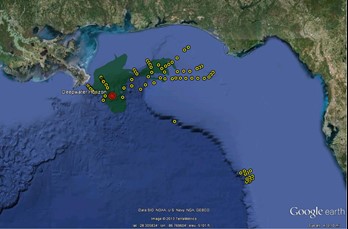
Prior to the Deep Water Horizon (DwH) oil spill in 2010, little research effort was focused on studying deep demersal elasmobranchs (sharks, skates, and rays) inhabiting the Gulf of America (GoAm). While the biology of these fishes remains virtually unknown, they are still routinely captured in commercial fisheries, both as targeted catch and as bycatch. In the absence of basic biological data, effective management plans cannot be formulated, making populations highly susceptible to declines. Additionally, because of this lack of basic biological data, it is unknown what effects the DwH oil spill will have on these organisms, and if the effects have the potential to result in population declines.
Sampling Methods
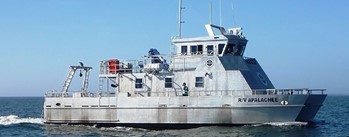
This research will complement a larger investigation that aims to study the ecology of deep demersal fishes in the northern GoAm. The demersal longline portion of this study is conducted quarterly aboard the R/V Apalachee, and the longline is modified to include 50 hooks with a range of hook sizes, as well as integrated traps. The depths that are sampled range from 200-2,000 m deep, and are located near the continental slope of the eastern GoAm through DeSoto Canyon. During each cruise 30-56 demersal longlines are set and hauled. This research will focus on fishes in the families Squalidae, Centrophoridae, and Triakidae, because members of these families are the most abundant species captured during these surveys and multiple species from each family are represented in the catch, allowing for an evolutionary component to the analyses.
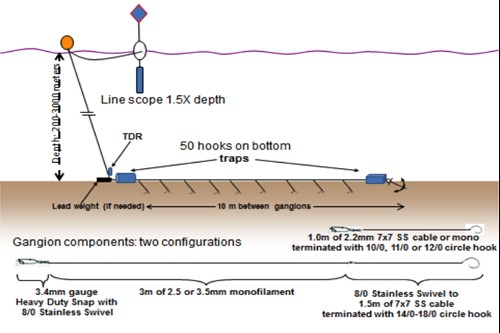
When an elasmobranch of interest is captured during the survey, the first assessment is core body temperature then a blood sample from the caudal vein will immediately be collected to attain a suite of baseline blood stress parameters, which includes: pH, lactate, pCO2, HCO3, glucose, and hematocrit. Remaining plasma will be analyzed for concentrations of potassium, chloride, sodium and calcium, and also assayed for the reproductive steroid hormones progesterone, testosterone and estradiol. Following blood-processing sharks will undergo a complete life history workup.
Stress Physiology
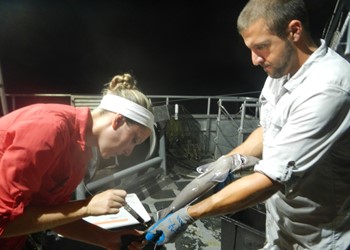
Currently, little is known regarding the physiological stress response of deep demersal elsamobranchs to capture or to physiological challenges such as those potentially imposed by the DwH spill. We will assess the physiological stress response of each elasmobranch sampled using the aforementioned blood chemical parameters, which have been demonstrated to indicate physiological stress in elasmobranchs. Comparisons of the stress responses of species inhabiting different depths will aid in determining if stress responses are mediated by depth, or rather shared taxonomic characteristics, while comparisons between different regions will allow for the assessment of potential effects of the DwH oil spill on these poorly studied species. In addition to using these blood chemical parameters as indicators of chronic stress potentially induced by the DwH oil spill, changes in growth and reproduction can also be indicators of population level effects of chronic stress in elasmobranchs. Identifying significant differences in these life history parameters between DwH affected and non-affected regions will provide insight into any chronic stress that may be occurring in deep demersal elasmobranchs as a result of the DwH oil spill.
Reproductive Physiology
Deep demersal elasmobranch species experience fewer seasonal fluctuations in environmental conditions than coastal species. As a result, these taxa often do not reproduce seasonally or synchronously, making assessment of reproductive status, maturity and gestational cycles difficult particularly using morphology and histology alone. In light of these challenges, we plan to analyze reproductive steroid hormones extracted from the blood of the aforementioned elasmobranchs, to support morphological and histological reproductive assessments. Specifically, we're interested in determining the characteristic reproductive steroid hormones of immature and mature elasmobranchs, whether there are seasonal or synchronous patterns in reproductive steroid hormones within these elasmobranch species and identifying the steroid hormones responsible for driving each stage of reproduction. Species-specific reproductive physiology will also be assessed to determine if seasonality and cycling are depth-mediated processes, or shared characteristics among more closely related taxon. Additionally, we will compare concentrations and patterns of reproductive steroid hormones in deep demersal elasmobranchs potentially affected by DwH with those from unaffected regions to assess the effects, if any, of DwH on reproductive endocrinology and biology.
Big Picture
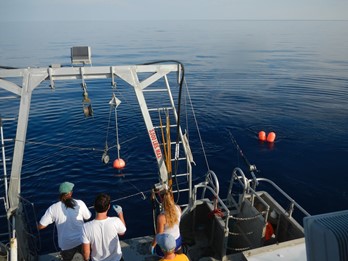
A thorough understanding of the basic biology of deep demersal elasmobranchs is essential and made much more evident in the wake of a catastrophic event, such as the DwH oil spill. In addition, many of these species are targeted in commercial fisheries or captured as bycatch; however, without knowledge of their reproductive biology or stress tolerance, the targeted and accidental capture of these fishes could quickly lead to overexploitation. The results of this research will provide basic biological data of deep demersal elasmobranchs, and differences observed between species will provide insight into whether physiological processes are depth-mediated adaptations, or taxonomically evolved traits, which are all essential data that can be incorporated into fisheries conservation and management plans. Furthermore, any significant differences in reproduction, growth, and blood stress parameters that are revealed between DwH affected and non-affected regions will give insight into the effects of oil spills on elasmobranch physiology and will provide vital data in the event of future oil spills

